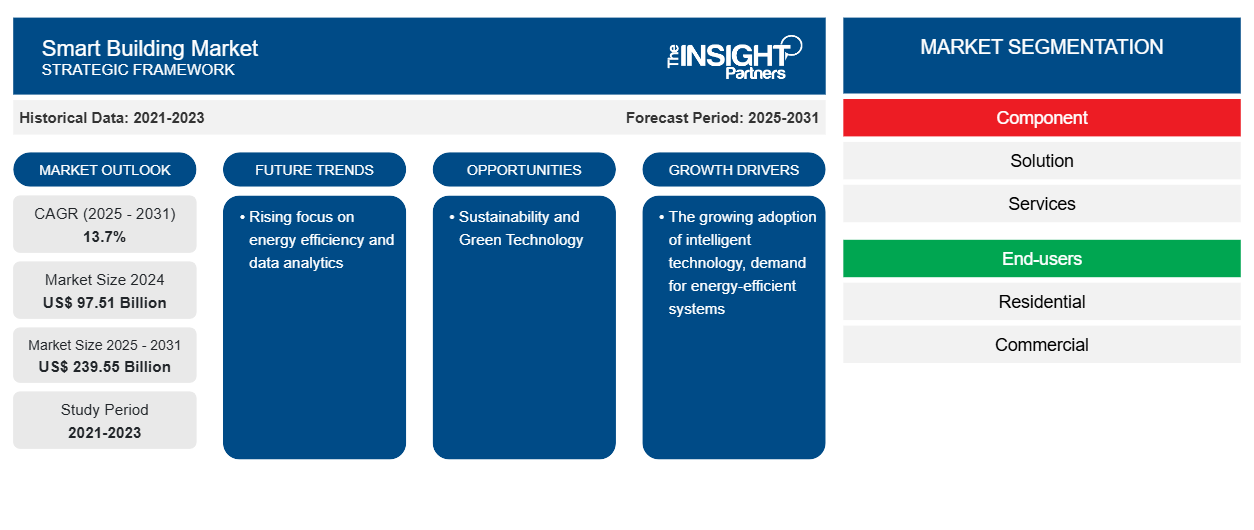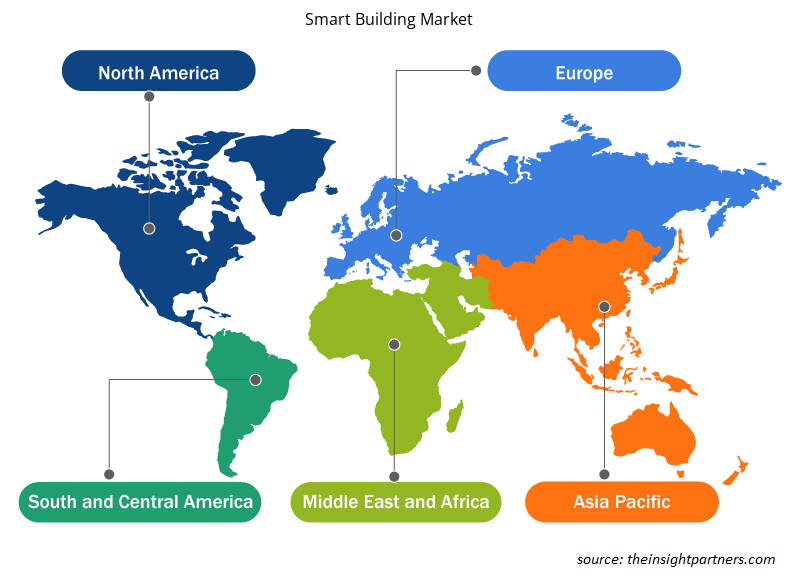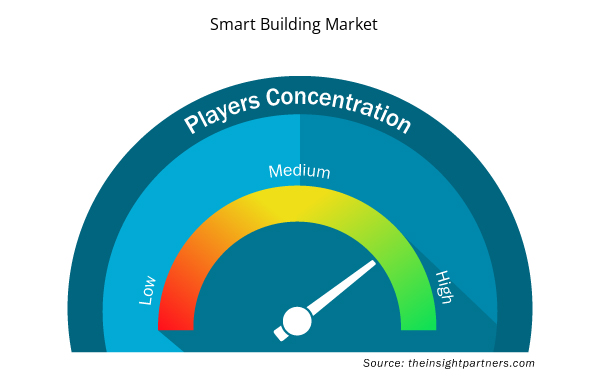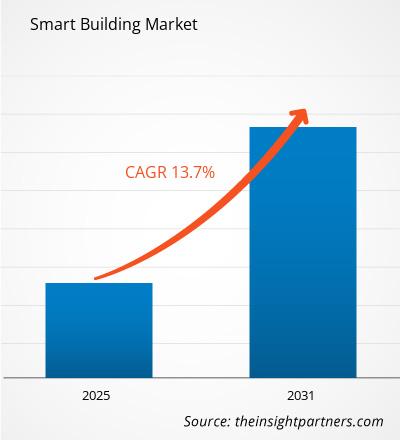The Smart Building market size is projected to reach US$ 239.55 billion by 2031 from US$ 85.76 billion in 2023. The market is expected to register a CAGR of 13.7% during 2023–2031. Rising focus on energy efficiency and data analytics are likely to remain key trends in the market.
Smart Building Market Analysis
In the smart building market, the use of various technology-enabled goods and services for enabling innovative building solutions has emerged from technological improvement. Furthermore, the increased usage of smart home and building automation systems has aided in improving operational efficiencies. Produce assets, vital components, equipment, and machinery for the building's smooth operation. For example, available smart building-related solutions currently include intelligent security solutions, energy management, building automation, and network management, among other solutions that enhance building efficiency.
Smart Building Market Overview
A smart building is a formation that controls building services such as ventilation, heating, air conditioning, security, lighting, and other systems using IoT and automated technology. A smart building collects and handles data using sensors, actuators, and microchips in line with an organization's (or household's) tasks and services. Such smart infrastructure solutions help facility managers improve asset reliability and performance, owners and operators, reduce energy consumption, improve space utilization, and reduce the environmental impact of buildings.
Customize This Report To Suit Your Requirement
You will get customization on any report - free of charge - including parts of this report, or country-level analysis, Excel Data pack, as well as avail great offers and discounts for start-ups & universities
Smart Building Market: Strategic Insights

- Get Top Key Market Trends of this report.This FREE sample will include data analysis, ranging from market trends to estimates and forecasts.
Customize This Report To Suit Your Requirement
You will get customization on any report - free of charge - including parts of this report, or country-level analysis, Excel Data pack, as well as avail great offers and discounts for start-ups & universities
Smart Building Market: Strategic Insights

- Get Top Key Market Trends of this report.This FREE sample will include data analysis, ranging from market trends to estimates and forecasts.
Smart Building Market Drivers and Opportunities
The Growing Adoption of Intelligent Technology and Demand for Energy-Efficient Systems to Favor the Market
The expanding use of intelligent technology and demand for energy-efficient systems drive the market CAGR for smart buildings. The growing urbanization is expected to propel the global smart building market growth. With the urbanization trend in mind, governments globally are investing in smart city initiatives for enhanced infrastructure, cleaner transportation, intelligent buildings, and other smart technology. The growing worry over rising global energy usage is expected to enhance innovative and energy-efficient technology.
The growing need for enhanced building utilization and better resource management in metropolitan settings pushes the use of intelligent buildings in diverse countries. The smart building uses IoT, and building operations such as heating, air conditioning, ventilation, lighting, security, and other systems are handled using automated technologies. Modern technology is increasingly used in smart buildings to collect and manage data through sensors, actuators, and microchips to deliver an organization's activities and services. Smart infrastructure solutions reduce energy consumption, enhance space utilization, and reduce the environmental impact of buildings. The rising demand for public safety and security is also propelling the rise of smart buildings. The introduction of 5G technology and the expansion of smart city projects are likely to provide profitable prospects for the growth of the smart building industry.
Sustainability and Green Technology
Sustainability in smart buildings is increasingly being driven by novel IoT and AI technologies that are tightly tied to ESG considerations. IoT sensors play an important role in monitoring and managing energy. AI algorithms are used to evaluate massive volumes of data from building operations, detecting trends and inefficiencies. Smart buildings incorporate ESG elements into their operations and administration. Advanced systems now track water usage, garbage generation, and other resource consumption. This improved approach to sustainability in smart buildings extends beyond traditional construction techniques to include the building's whole lifecycle and operation.
Smart Building Market Report Segmentation Analysis
Key segments that contributed to the derivation of the smart building market analysis are component and end-user.
- Based on component, the smart building market is divided into solution and services. Building infrastructure management, security and emergency management, and energy management are prominent subsegments under the solutions segment. Support and maintenance, system integration, and deployment are prominent subsegments under the service segment. The solution segment held a larger market share in 2023.
- By end-user, the market is segmented into residential and commercial.
Smart Building Market Share Analysis by Geography
The geographic scope of the smart building market report is mainly divided into five regions: North America, Asia Pacific, Europe, Middle East & Africa, and South & Central America.
North America holds a prominent share in the market. Intelligent security systems are predicted to increase exponentially in North America. As environmental awareness grows, more Americans search for connected, smart, and automated building solutions with add-on capabilities such as fire protection, safety and alarm systems, surveillance, and security. As a result, IoT-enabled solutions are becoming increasingly popular in the United States. The United States is one of the largest 10T-enabled markets in North America, as it is the largest user of IOT-compatible products.
Smart Building Market Regional Insights
The regional trends and factors influencing the Smart Building Market throughout the forecast period have been thoroughly explained by the analysts at Insight Partners. This section also discusses Smart Building Market segments and geography across North America, Europe, Asia Pacific, Middle East and Africa, and South and Central America.

- Get the Regional Specific Data for Smart Building Market
Smart Building Market Report Scope
| Report Attribute | Details |
|---|---|
| Market size in 2024 | US$ 97.51 Billion |
| Market Size by 2031 | US$ 239.55 Billion |
| Global CAGR (2025 - 2031) | 13.7% |
| Historical Data | 2021-2023 |
| Forecast period | 2025-2031 |
| Segments Covered |
By Component
|
| Regions and Countries Covered | North America
|
| Market leaders and key company profiles |
Smart Building Market Players Density: Understanding Its Impact on Business Dynamics
The Smart Building Market market is growing rapidly, driven by increasing end-user demand due to factors such as evolving consumer preferences, technological advancements, and greater awareness of the product's benefits. As demand rises, businesses are expanding their offerings, innovating to meet consumer needs, and capitalizing on emerging trends, which further fuels market growth.
Market players density refers to the distribution of firms or companies operating within a particular market or industry. It indicates how many competitors (market players) are present in a given market space relative to its size or total market value.
Major Companies operating in the Smart Building Market are:
- Cisco
- IBM
- Honeywell HBT
- Siemens
- Johnson Controls
- Huawei Technologies Co. Ltd.
Disclaimer: The companies listed above are not ranked in any particular order.

- Get the Smart Building Market top key players overview
Smart Building Market News and Recent Developments
The smart building market is evaluated by gathering qualitative and quantitative data post primary and secondary research, which includes important corporate publications, association data, and databases. A few of the developments in the Smart Building market are listed below:
- Siemens, a global leader in infrastructure, mobility, and industry technology, partnered with PRODEA Investments, Greece's leading real estate investment firm and one of the largest in Southeast Europe, to implement Building X, a Siemens digital building platform. The collaboration aims to expedite PRODEA Investments' digital transformation, reduce the carbon footprint of existing and under-construction building assets across its Greek real estate portfolio, and provide additional value services to renters. (Source: Siemens, Newsletter, 2023)
- Based on the Joint Venture Agreement signed on January 23, 2023, Obayashi Corporation and Hitachi Solutions, Ltd. created Oprizon, Ltd. ("Oprizon"), a joint venture delivering smart building-related services. Horizon began operations on April 1, 2023, intending to be the top smart building services provider. (Source: Hitachi Solutions, Ltd., Newsletter, 2023)
Smart Building Market Report Coverage and Deliverables
The “Smart Building Market Size and Forecast (2021–2031)” report provides a detailed analysis of the market covering below areas:
- Smart building market size and forecast at global, regional, and country levels for all the key market segments covered under the scope
- Smart building market trends as well as market dynamics such as drivers, restraints, and key opportunities
- Detailed PEST/Porter’s Five Forces and SWOT analysis
- Smart building market analysis covering key market trends, global and regional framework, major players, regulations, and recent market developments
- Industry landscape and competition analysis covering market concentration, heat map analysis, prominent players, and recent developments for the smart building market
- Detailed company profiles
- Historical Analysis (2 Years), Base Year, Forecast (7 Years) with CAGR
- PEST and SWOT Analysis
- Market Size Value / Volume - Global, Regional, Country
- Industry and Competitive Landscape
- Excel Dataset



Report Coverage
Revenue forecast, Company Analysis, Industry landscape, Growth factors, and Trends

Segment Covered
Component, End-users, and Geography

Regional Scope
North America, Europe, Asia Pacific, Middle East & Africa, South & Central America

Country Scope
This text is related
to country scope.
Frequently Asked Questions
The market is expected to register a CAGR of 13.7% during 2023–2031
The smart building market size is projected to reach US$ 239.55 billion by 2031
Rising focus on energy efficiency and data analytics are likely to remain key trends in the market.
Cisco, IBM, Honeywell HBT, Siemens, Johnson Controls, Huawei Technologies Co. Ltd., Intel Corporation, PTC, ABB, Hitachi Ltd, Schneider Electric, Legrand, Verdigris Technologies, Switch Automation, Huawei Technologies, Cohesion, Igor, United Technologies, Iota Communications, Budderfly, and Ortronics among the leading payers operating in the smart building market.
The growing adoption of intelligent technology and demand for energy-efficient systems are expected to drive the smart building market.
The global smart building market was dominated by North America in 2023.

 Get Free Sample For
Get Free Sample For